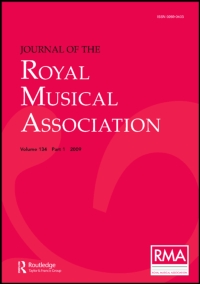No CrossRef data available.
Article contents
On Some of the Underlying Principles of Structure in Musical Composition
Published online by Cambridge University Press: 01 January 2020
Extract
My subject may seem, in title at least, technical and formal rather than aesthetic: having to do more with that which is outlined and made than with that which is inwrought and felt; with body and shape rather than with spirit and essence. So sorry, however, should I be for it to be thought that I approach the consideration of the beautiful art which we all love, in any of its richly varied aspects, with the spirit of a pedant, or as seeming to countenance the notion that music may be made or constructed merely, without being felt or inspired, that I must at the outset, as the truest introduction to the specialties of my subject, as well as to place myself right with the art and with my audience, say emphatically that, in proposing to myself to deal with some of the underlying principles of structure in musical composition, I wish to speak of structure as the expression of definite thought; as the result of that thought; as having to do with the form that the thought assumes, rather than with the shape or mould into which it is cast. Architecture has been termed “the poetry of mathematics”: that would not be said of building, which is not the expression of a poetical thought at all. So with music, the poetry of sound—or rather, perhaps, poetical feeling expressing itself through sound: the very form that it assumes is the resultant expression of the thought.
- Type
- Research Article
- Information
- Copyright
- Copyright © Royal Musical Association, 1880
References
∗ Ephesians ii. 10.Google Scholar
∗ Job xiv. 4Google Scholar
† Ruskin's Fors Clavigera, Letter 83, 1877.Google Scholar
‡ Ibid.Google Scholar
∗ I Corinthians xiv. 22.Google Scholar
∗ Fall means cadence.Google Scholar
∗ F. Buckland's Curiosities of Natural History, Second Series, p. 156.Google Scholar
† Ruskin's Elements of Drawing.Google Scholar
∗ In my Text-Book of Music, chap. xxvi.Google Scholar


